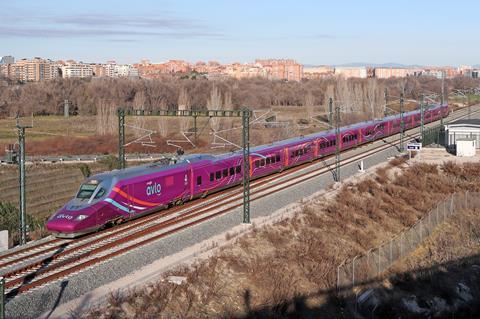
SPAIN: Trial running began through the third cross-city tunnel between Madrid Chamartín and Madrid Atochaover the weekend of February 5-6. Rolling stock chosen for the trials consisted of a pair of S112 Talgo trainsets refitted for national operator RENFE’s low-cost Avlo services.
In contrast to the two existing Chamartín – Atocha tunnels, both of which are laid with 1 668 mm gauge track, the third bore is equipped with two 1 435 mm gauge tracks and represents the first integration of the 1 435 mm high speed lines north and south of the Spanish capital. This means that high speed services running north-south through Madrid will no longer need to pass through gauge changing installations north of Chamartín and south of Atocha.
Not only will the third tunnel avoid the time penalty and access charges levied by infrastructure manager ADIF for use of the gauge changers, it will also allow operation of more cross-capital high speed services. This is because operations will no longer be restricted to RENFE’s variable-gauge Class S130 and S730 trainsets which are limited to a maximum speed of 250 km/h. In theory at least, any 1 435 mm gauge high speed train used in Spain will be able to pass through the tunnel, including those deployed by RENFE’s open access competitors.
Work on the third 7 km cross-city tunnel was authorised in summer 2008 at a cost of €356m, and construction began the following year. The bore was completed in 2011, but soon afterwards work slowed to a halt. In 2013 the scheme was budgeted at €826m, although it now included construction of a 23∙7 km double track line parallel to the existing high speed line southwards to a flying junction at Torrejón de Velasco where Valencia bound services diverge from the route to Sevilla.
The two extra tracks were judged necessary to avoid capacity problems on the high speed line to Andalucia ― prior to the 2008 economic crisis, forecasts for the number of long-distance and suburban passengers using Madrid Atocha station indicated that traffic would increase from 9 million a year in 2006 to 24 million by 2020. Future sources of traffic could include Madrid-Barajas airport, where dual-gauge track is already in place.
By late 2014, the third tunnel was complete with slab track in position. Tracklaying south of Atocha was in progress by mid-2016 and this was finished by March 2017. The 25 kV 50 Hz catenary was energised on August 22 that year.
For the moment there are no platforms on the 1 435 mm gauge tunnel tracks where they pass through Atocha. Nor is there any clear indication when the third tunnel will be opened for commercial traffic. In July 2020 the Ministry of Transport, Mobility & Urban Agenda indicated that inauguration could occur ‘towards the end of 2020’, but so far no date has been announced.

















